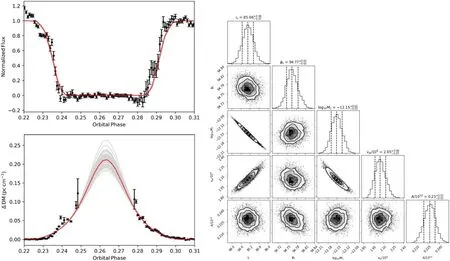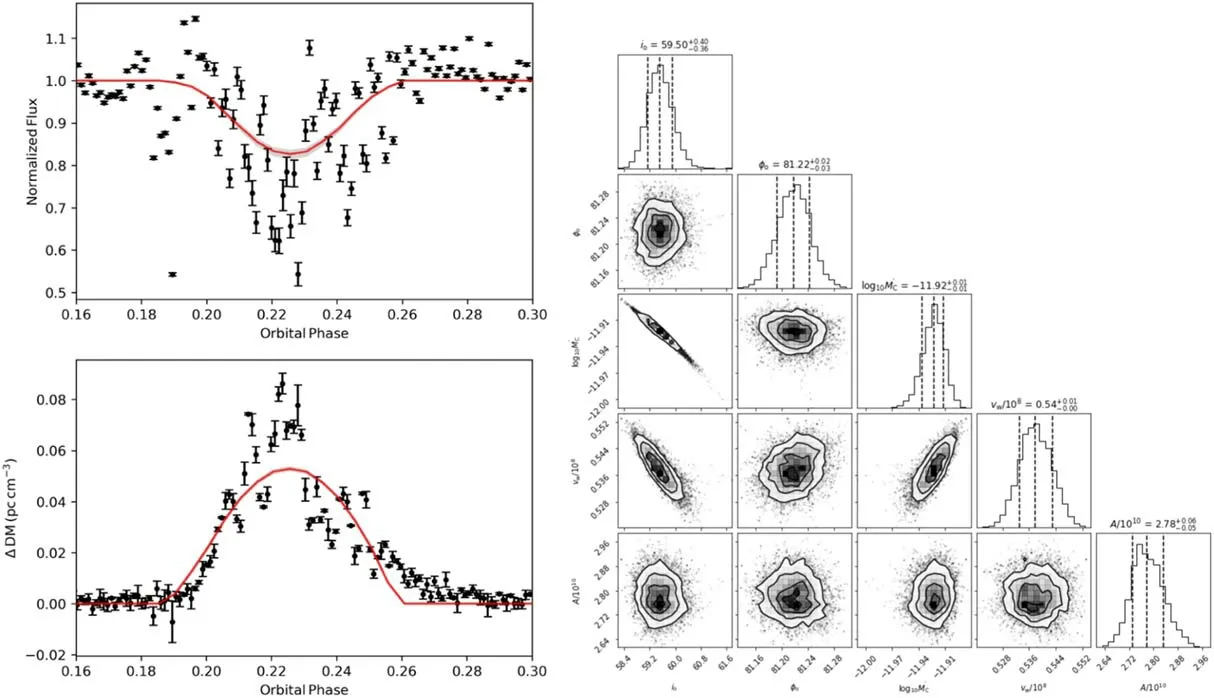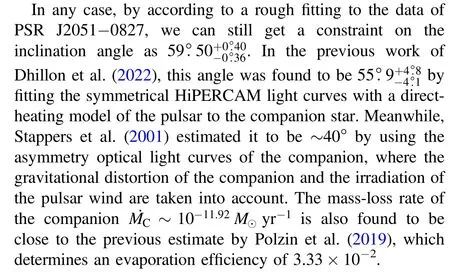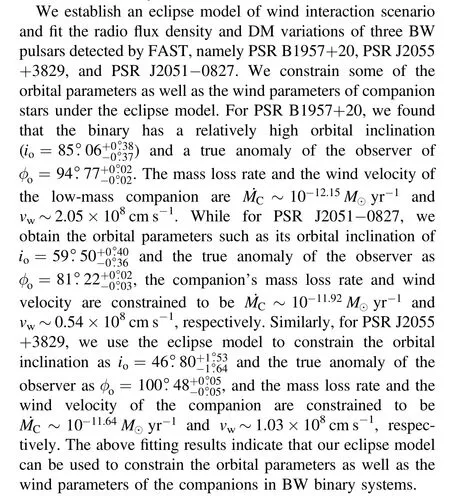Constraining the Orbital Inclination and Companion Properties of Three Black Widow Pulsars Detected by FAST
Ze-Xin Du (杜泽昕), Yun-Wei Yu (俞云伟),2, A-Ming Chen, Shuang-Qiang Wang (王双强), Xia Zhou (周霞),5,6, and Xiao-Ping Zheng (郑小平),2
1 Institute of Astrophysics, Central China Normal University, Wuhan 430079, China; yuyw@mail.ccnu.edu.cn 2 Key Laboratory of Quark and Lepton Physics, Central China Normal University, Ministry of Education, Wuhan 430079, China 3 Tsung-Dao Lee Institute, Shanghai Jiao Tong University, Shanghai 201210, China; chensm@mails.ccnu.edu.cn 4 Xinjiang Astronomical Observatory, Chinese Academy of Sciences, Urumqi 830011, China 5 Key Laboratory of Radio Astronomy, Chinese Academy of Sciences, Nanjing 210008, China 6 Xinjiang Key Laboratory of Radio Astrophysics, Urumqi 830011, China Received 2023 July 20; revised 2023 September 25; accepted 2023 October 9; published 2023 November 28
Abstract Black widows (BWs) are millisecond pulsars ablating their companion stars.The out-flowing material from the companion can block the radio emission of the pulsar,resulting in eclipses.In this paper,we construct a model for the radio eclipse by calculating the geometry of the bow shock between the winds of the pulsar and companion,where the shock shapes the eclipsing medium but had not been described in detail in previous works.The model is further used to explain the variations of the flux density and dispersion measure of three BW pulsars (i.e., PSR B1957+20, J2055+3829, and J2051−0827) detected by the Five-hundred-meter Aperture Spherical radio Telescope.Consequently, we constrained the parameters of the three BW systems such as the inclination angles and true anomalies of the observer as well as the mass-loss rates and wind velocity of the companion stars.With the help of these constraints, it is expected that magnetic fields of companion stars and even masses of pulsars could further be determined as some extra observation can be achieved in the future.
Key words: (stars:) pulsars: individual (PSR B1957+20, PSR J2055+3829, PSR J2051-0827) – (stars:) binaries:eclipsing – stars: winds – outflows
1.Introduction
Millisecond pulsars (MSPs) are rapidly rotating neutron stars, with a large number of them being discovered in binary systems.It is widely believed that MSPs are spun up via angular momentum transfer from their companion star through accretion processes (Bhattacharya 1996).Redbacks (RBs) and black widows(BWs),widely known as spider pulsars,are subpopulations of MSPs that can evaporate their donors persistently by their powerful winds.Masses of RB companion stars are usually within the range of ∼(0.2–0.4)M⊙, while BW companions with a range of ∼(0.02–0.05)M⊙(Roberts 2011;Polzin et al.2019).The optical observations of RB and BW binaries confirmed that the surface of their companion stars could be strongly irradiated by the energetic pulsar winds(Khechinashvili et al.2000).Furthermore, observations at higher energies also discovered the X-ray emission arising from the interaction of the pulsar wind with the evaporation material (Kluzniak et al.1988; Phinney 1988).
According to observations, the eclipse regions of spider pulsar binaries are typically larger than the Roche lobes of the companion stars, and therefore the eclipse is not solely caused by the companion star’s obscuration, but probably due to the absorption of the radio pulse signal by the surrounding plasma around the companion star,especially during the beginning and ending stages of the eclipse.Since the low-mass companion stars are surrounded by a diffuse evaporation halo, the radio emission from the MSPs can in principle be eclipsed by the evaporation halo as it appears on the line of sight (LOS) of observers near inferior conjunctions (Guillemot et al.2019).Such eclipses can happen as long as the orbital inclination of the binary is high enough.The first discovered eclipsing BW in radio observation is PSR B1957+20 (Fruchter et al.1988).About 10%of its orbital phase was found to be eclipsed,which cannot be covered by the range of the Roche lobe of its companion and thus the ablated material must replenish the eclipse medium to be beyond the Roche lobe (Ray & Loeb 2017; Polzin et al.2019).Therefore, it is expected that the study of the MSP eclipses can help to probe the property of the evaporation material and, furthermore, of the companion stars.Meanwhile, a constraint on the orbital parameters of the binaries could also be obtained.
The physical processes of eclipsing pulsars had been investigated thoroughly by Thompson et al.(1994), by confronting the observational results of PSR B1957+20 and PSR J1748−2446A.The correlation between the eclipse duration and the frequency of PSR J2215+5135 was studied by Broderick et al.(2016), who suggested that the primary effect of the eclipsing medium is to absorb the radio emission rather than scattering it.Polzin et al.(2019) reported the radio observations of PSR J2051−0827 in the frequency range of 110−4032 MHz and found that the scattering and/or cyclotron absorption provides the most promising eclipse mechanism.Kudale et al.(2020)further suggested the absorption is primarily due to the cyclotron-synchrotron process, by explaining the excess dispersion, scattering, and absorption of PSR J1227−4853.In any case,it is worth mentioning that cyclotron absorption requires a strong magnetic field in the eclipse medium.
In the last decade, many eclipsing pulsar binaries have been discovered,which allows us to study the eclipse mechanisms in more detail (Bhattacharyya et al.2013; Guillemot et al.2019;Nieder et al.2020).In particular, the Five-hundred-meter Aperture Spherical radio Telescope (FAST) has implemented plenty of radio observations for several BW pulsars such as PSR B1957+20, PSR J2055+3829, and PSR J2051−0827,including long-term measurements of their flux density and dispersion measure (DM; Wang et al.2023).Furthermore,rotation measure (RM) variation was found in PSR J2051−0827.Therefore, at the current stage, it is necessary to combine these observational results with the eclipse processes to constrain the physical properties of binary systems.
In the next section, we introduce an eclipse model by taking into account the shock interaction between the winds of the pulsar and companion star as well as the consequent geometry of the shock.Then, we apply the model to fit the light curves and DM variations of the three FAST BWs in Section 3.The implications of the parameter constraints for the binary systems are discussed in Section 4.Finally, a conclusion is given in Section 5.
2.The Model
The geometry of the eclipse medium is determined by the shock surface between the pulsar wind and stellar wind as well as a magnetosphere (Romani & Sanchez 2016; Wadiasingh et al.2017).Recently,Chen et al.(2021)investigated the shock interaction of a pulsar with an O/B star in some high-mass gamma-ray binaries and estimated the radio emission window of these pulsars.The primary difference between the spider pulsar binaries from the gamma-ray binaries is that,in the latter case,the intense wind from the O/B star can nearly enclose the pulsar, whereas in the former case, the stellar wind can only blow a conical region.The geometry of the bow shock due to the interaction of the spider pulsar wind with the companion wind is depicted in Figure 1, which is determined by the mechanical balance between the two shocked wind regions.The most crucial parameter is the momentum rate ratio between the winds as:
where Lsdis the spin-down power of the pulsar, c is the speed of light, ˙MCis the mass loss rate of the companion star,and vwis the terminal speed of this wind.
Following Chen et al.(2021), when the LOS of observers can intersect with the bow shock, the radio emission from the pulsar would be suppressed as Fν(ν)=Fν,0·e−τ(ν), where the optical depth of the companion wind on the LOS is considered to be dominated by the free–free absorption (FFA) process as:
where α(ν;T,ne,ni)is the FFA coefficient,which is dependent on the temperature (T) of the medium and the density of the electrons(ne)and ions(ni),and the value of lp,obsis determined by the shape of the bow shock.Here, the FFA process rather than the cyclotron/synchrotron processes is invoked, because the latter processes usually require a strong magnetic field.The strength of the magnetic field could in principle be measured by detecting the variation of the RM of the radio emission near the eclipse boundaries(Polzin et al.2019;Kudale et al.2020).For the spider pulsar PSR B1957+20,Li et al.(2019)measured its RM values and found no evidence for large-scale magnetic fields over the egress plasma lensing region.Besides the radio suppression effect, the companion wind can further provide an extra contribution to the DM of the pulsar radio emission,which leads to a DM variation as
where neis the electron number density, which is determined by the hydrogen abundance of the wind and the distance to the center of the companion star.Specifically, we can relate the electron number density with the ion density by ne=niμi/μe,where the typical values of the mean ion molecular and electron weight are taken as μi∼1.29 and μe∼1.18, respectively(Zdziarski et al.2010).
In order to complete the above integrals, we write the number density of the companion wind (i.e., the ion density ni=nw) as a function of the radius r to the companion as(Waters et al.1988):
where the base density nw,0at the stellar surface r⋆can be defined as:


Figure 1.Left:Illustration for the general case of the orbital inclination(io)and the true anomaly of the LOS(φo)in spider pulsar binary systems.Right:Description of bow shock structure in spider binary systems of the companion star.
On the other hand, the temperature of the stellar wind gradually decreases through adiabatic cooling with increasing radial distance from the surface of the companion star.As a result, the temperature distribution can be empirically expressed by a power law as (Kochanek 1993):
where T⋆is the effective temperature of the star at r⋆andA≡.The value of the index β depends on the adiabatic index of the wind gas, which could range within ∼(2/3–4/3).In the following calculations, we simply adopt β = 2/3.Strictly speaking, the stellar surface temperature is actually anisotropic due to the irradiation by the pulsar and thus the temperature T⋆involved here can only be treated as an effective one.Nevertheless,it should still be noticed that the temperature directly involved in the calculation is actually the temperature of the wind material far away from the stellar surface, where the anisotropy of the temperature is very likely to be not as significant as on the stellar surface.
By confronting the above model with the radio observations by spider pulsars,we can constrain the model parameters of the binary orbit (the inclination angle ioand the true anomaly of observer φo) and of the companion star ( ˙MC, vw, and A).
3.Fitting the Flux and DM Variations
3.1.PSR B1957+20
PSR B1957+20 is the first MSP discovered in a binary with a low-mass companion star,and it is classified to be a BW system.The period and eccentricity of the binary orbit are Porb∼9.2 hr and e<4.0×10−5(Arzoumanian et al.1994).PSR B1957+20 has a spin period of 1.607 ms and a spin-down luminosity of Lsd∼1.6×1035erg s−1(Fruchter et al.1988).During the eclipse phase,the flux density of PSR B1957+20 also decreases to nearly zero,which makes it unable to obtain the value of DM.In the left panel of Figure 2, we present the observational data centered at ν ∼1.25 GHz on 2022 September 2, which covers the whole eclipsing period and lasts 14,340 s, where the flux density is normalized by the pre- and post-eclipse emission (S.Q.Wang et al.2023,in preparation).Solid lines represent fittings of the data,and the goodness of fitting is evaluated with the MCMC method.The observational constraints on the model parameters are shown in the right panel of Figure 2 and the corresponding parameter values with 1σ errors are listed in Table 1.
The obtained inclination angle of ~ 85°.06indicates the orbit of PSR B1957+20 is nearly viewed edge-on, which is consistent with the result(io∼85°)given by Johnson et al.(2014)through their MSP light curves simulation model.In comparison,Reynolds et al.(2007) derived a relatively smaller inclination of io=65°±2° from the photometric data of the William Herschel Telescope and Hubble Space Telescope.Alternatively, Kandel et al.(2021) constrained the inclination to be io∼75°.8±5°.9 by using the X-ray emission arising from the stellar wind interactions.


Figure 2.Left:Normalized flux density and DM variations of PSR B1957+20 during the eclipse phase.The solid lines give the model fittings for the observational data.Right:Corner plot showing the posterior distributions of the model parameters.

Table 1 Parameters and Fitting Results of PSR B1957+20, PSR J2051−0827, PSR J2055+3829

3.2.PSR J2051-0827
PSR J2051−0827 is the second eclipsing MSP discovered after PSR B1957+20.The MSP is in a 2.38 hr orbit around the companion star with an eccentricity of 3×10−4.The pulsar has a spin period of 4.508 ms and a spin-down luminosity of 6×1033erg s−1.Radio observations at low frequency(ν ≤0.6 GHz) show eclipse features covering 10% of the orbital period(Stappers 1996).The FAST observations of PSR J2051−0827 centered at ν ∼1.26 GHz was carried out on 2022 January 14 with a duration of 8940s,covering the entire binary orbit (Wang et al.2023).The observational data are displayed in the left panel of Figure 3,which shows the radio emission of the pulsar was not completely obscured during the eclipse.Furthermore, in comparison with the previous source, the data of PSR B1957+20 has a much larger scatter, which makes it impossible to obtain a good fitting with a simple model.A possible explanation for the large fluctuation of the data is that the stellar wind in this source is very unstable and inhomogeneous.

Figure 3.The same to Figure 2 but for PSR J2051−0827.

3.3.PSR J2055+3829
PSR J2055+3829 was first discovered by the SPAN512 survey conducted with the Nançay Radio Telescope,which has a spin period of 2.08 ms and a spin-down luminosity of Lsd∼4.3×1033erg s−1(Guillemot et al.2019).As another BW pulsar, PSR J2055+3829 is in a binary with a very low mass companion of a tight orbit.S.Q.Wang et al.(2023, in preparation) conducted observations on PSR J2055+3829 for 11,640 s centered at 1.25 GHz on 2021 August 30,and found a clear eclipse with a duration of 1467±12 s, which is about 13%of the orbital period.The observational data are shown in the left panel of Figure 4, in comparison with the modeling curves.
4.Discussion and Implications
4.1.RM Measurements and Magnetic Fields
For PSR J2051−0827, Polzin et al.(2019) utilized the linearly and circularly polarized flux to investigate the possible presence of magnetic fields through the measurements of RM,Faraday delay, and depolarization.As a result, the average magnetic field parallel to the LOS was constrained to be within the range of 10−4G ≤B//≤102G.Very recently,Wang et al.(2023) detected a regular decrease of the RM of PSR J2051−0827 in the egress of the eclipse.i.e., the RM gradually change back to normal when the LOS moves away from the eclipse medium, as shown by the data points in Figure 5.This measurement provided direct evidence for the existence of magnetic fields in the eclipse medium.

Figure 4.The same to Figure 2 but for PSR J2055+3829.

Figure 5.A comparison of the model-predicted RM variation of PSR J2051−0827 during the eclipse phase with the observational data(solid circles),where a typical magnetic field structure is adopted as presented in Equation(9).Different values for the parameter B⋆and the inclination of the magnetic axis φm are taken as labeled in the legend, while the other model parameters are taken as listed in Table 1.The observational data are taken from Wang et al.(2023).
In theory, based on the obtained constraints on the orbital and companion wind properties,we can in principle predict the possible variation of RM of the spider pulsars by
by adopting a specific description of the magnetic field in the stellar wind(Bw).Typically,we can express the magnetic field as a combination of the radial and toroidal components as(Bosch-Ramon & Khangulyan 2011):
with
where B⋆is the magnetic field strength at r⋆and the surface rotation velocity of the companion star is assumed to be vw,φ∼0.1vw(r⋆/r).Finally, it needs to be pointed out that the symmetric axis of the above magnetic field could be not parallel to the angular momentum of the binary, but probably has an inclination angle of φmrelative to the normal of the orbital plane, which would also influence the RM variation.Here the binary is assumed to be tidally locked.

4.2.The Companion Surface Temperature and Pulsar Masses
As the radius of the companion star of PSR J2051−0827 had

the one given by Stappers et al.(1996b)as T⋆=4000–4700 K,which was estimated from the observed R −I color according to the cool M-type dwarf relations of Bessell.For PSR J2055+3829, if we use the Roche lobe radius RL∼0.14 R⊙to approximate the companion radius, which is reasonable for an appropriate mass ratio between the pulsar and the companion(Guillemot et al.2019), we can estimate the surface

much lower than that found by Reynolds et al.(2007) and is probably unrealistic.This indicates that the value of β=2/3 may not be always appropriate for the companions or Equation (6) for a constant index is not strictly correct,especially for the wind very close to the stellar surface.In addition, we would like to emphasize again that the temperature of the companion should in fact be anisotropic due to the irradiation of pulsar wind and the temperature obtained from the fitting of the radio flux and DM is only an effective value, which might be regarded as an average temperature.
In any case, the determination of the companion surface temperature would in principle help us to calculate their emission luminosity and,furthermore,to estimate the masses of the companions by according to an empirical mass–luminosity relationship.Meanwhile, the determination of the inclination angle of the BW binaries enables us to fix the mass function of the binaries as
where Mpand MCare the masses of the pulsar and companion,respectively.To be specific, the Mp−MCrelationships of the three FAST BW binaries are displayed in Figure 6.Then,if the companion masses can indeed be obtained from the temperature measurement, it is expected that the pulsar masses would finally be constrained.
5.Summary and Conclusion
The study of pulsar eclipse processes occurring in BW systems can provide a more accurate perception of binary orbits and their companions.It is proposed that the radio emission from the pulsar is absorbed by the outflows of its companion.The interaction of the pulsar wind with the stellar wind forms a bow shock, and the stellar outflows in the shock-wrapped companion side cause the radio eclipse when the star moves around inferior conjunctions.

In addition,our eclipse model still needs further refinement,as for the evidence of the magnetic field in the RM variation detected in the late stage of the eclipse.We suggest that it is not dominated by the magnetic field of the companion star but by the interaction between the magnetic field of the pulsar wind and the bow shock, which relies on a more accurate description of the magnetic field around the bow shock.Furthermore, if the mass and radius of the companion can be given directly by optical observations, we can also make an estimate of the mass of the pulsar in the BW systems by eclipse.
Acknowledgments
We thank the referee for useful comments on the manuscript.This work is supported by the National SKA program of China(2020SKA0120300),the National Key R&D Program of China(2021YFA0718500), the National Natural Science Foundation of China (grant Nos.11833003 and 12033001), the China Postdoctoral Science Foundation (No.2023T160410), and the Opening Foundation of Xinjiang Key Laboratory (No.2021D04016).
 Research in Astronomy and Astrophysics2023年12期
Research in Astronomy and Astrophysics2023年12期
- Research in Astronomy and Astrophysics的其它文章
- Large-scale Dynamics of Line-driven Winds with the Re-radiation Effect
- A Study of Elemental Abundance Pattern of the r-II Star HD 222925
- Preliminary Study of Photometric Redshifts Based on the Wide Field Survey Telescope
- Solar Observation with the Fourier Transform Spectrometer.II.Preliminary Results of Solar Spectrum near the CO 4.66μm and MgI 12.32μm
- Density Functional Theory Calculations on the Interstellar Formation of Biomolecules
- Detection Capability Evaluation of Lunar Mineralogical Spectrometer:Results from Ground Experimental Data
